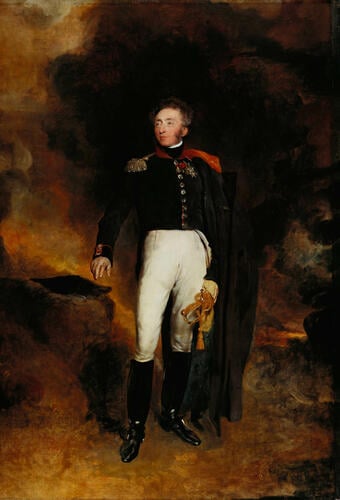Louis-Antoine, Duke of Angoulême (1775-1844) 1825
Oil on canvas | 270.4 x 178.1 x 4.0 cm (support, canvas/panel/stretcher external) | RCIN 405142
-
The Duke of Angouleme was the nephew of the last pre-Revolution French King, Louis XVI (1754-1793). During the Revolution he joined the Royalist army and lead the Vendee rising in 1795; throughout the Napoleonic Wars he fought on the allied side, living in England from 1807 to 1814 and serving under the Duke of Wellington. The Restoration of 1815 brought his uncle Louis XVIII (1755-1824) to the throne, followed by his father, Charles X (1757-1836). At the revolution of 1830 his father abdicated and he succeeded him, as Louis XIX, for a twenty-minute reign, after which he decided that it would be prudent to abdicate as well. His final years were spent in exile in Austria. George IV commissioned this portrait, with that of the sitter's father, Charles X (RCIN 405138), in 1825 at a cost of 500 guineas each. Lawrence executed both in Paris in August to November 1625. Angouleme is shown standing in a landscape against a sky full of the storms of war, wearing military uniform, with a cloak over his shoulder and clasping a sword. George IV took possession of this portrait in 1829; at which time it was hung in St James's Palace. By the 1840s it was hanging, as it does today, in the 'Waterloo Chamber', though whether or not originally intended for that location is uncertain. The Waterloo Chamber is a great hall on the public route at Windsor Castle displaying portraits of those soldiers, sovereigns and diplomats responsible for the overthrow of Napoleon and the re-establishment of the monarchies and states of Europe thereafter. The concept began in 1814 when George IV used the opportunity of the Treaty of London to commission Lawrence to paint distinguished visitors. The group of portraits grew during the next decade as Lawrence continued to obtain portrait sittings at the various congresses following the Battle of Waterloo in 1815 and, in some cases, by making special journeys. Most of the twenty eight portraits were delivered after his death on 7 January 1830. By this time work was already begun of the space of the Waterloo Chamber created by covering a courtyard at Windsor Castle with a huge sky-lit vault; the room was completed during the reign of William IV (1830-7). The first illustration of the interior is provided by Joseph Nash (1809-78) in 1844 (RCIN 919785) and shows the arrangement which survives to this day: full-length portraits of warriors hang high, over the two end balconies and around the walls; at ground level full-length portraits of monarchs alternate with half-lengths of diplomats and statesmen.
Provenance
Painted for George IV for 500 guineas; initially hanging in the King's Closet at St James's Palace; taken to the Waterloo Chamber at Windsor Castle
-
Medium and techniques
Oil on canvas
Measurements
270.4 x 178.1 x 4.0 cm (support, canvas/panel/stretcher external)
270.4 x 183.0 x 4.5 cm (support, canvas/panel/stretcher external)
258.0 x 182.5 cm (sight)
Other number(s)
Alternative title(s)
Louis-Antoine, Duc d'Angoulême (1775-1844)









